Is my roof suitable for solar panels? A complete checklist of 9 key factors to consider.
As energy costs rise, more UK homeowners are turning to solar panels for a more affordable and sustainable power source. According to a new CPRE (Campaign to Protect Rural England, now known as Countryside Charity) report, more than half the solar panels needed to hit net zero targets can fit on roofs and in car parks.
In England alone, there are 650 square kilometres of rooftops and car parks suitable for solar panels that’s not currently being utilized!
So, that begs the question: Is your roof suitable for solar panels?
The answer?
Very likely, read on!
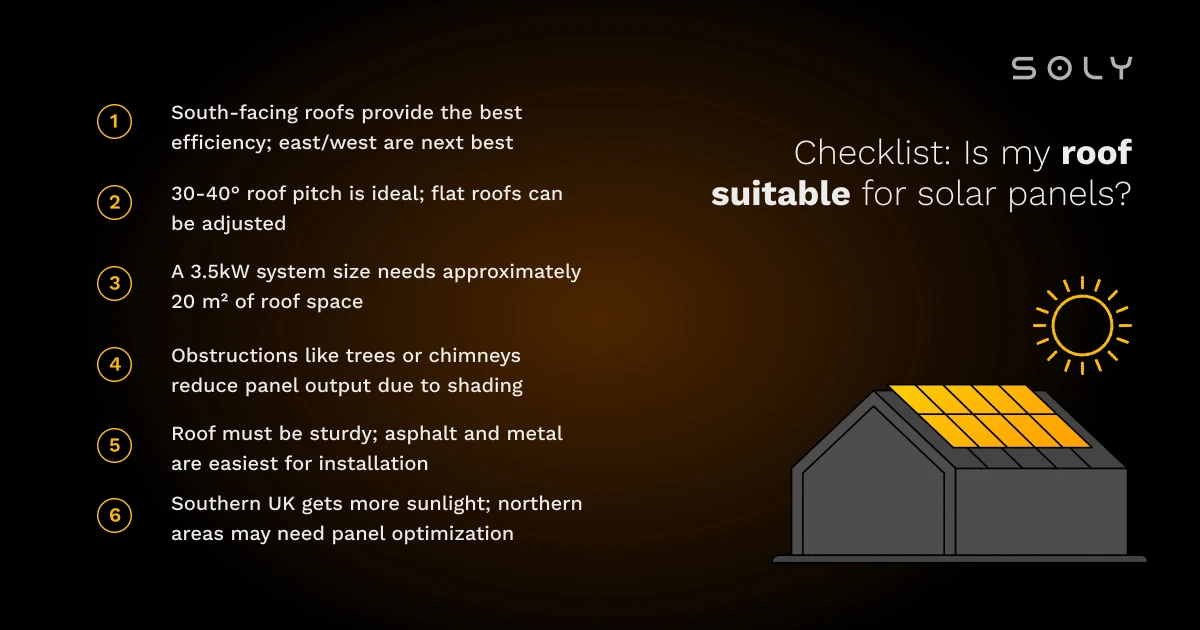
When assessing a roof’s suitability for solar panels, there are several factors that come into play, like the direction your roof faces, its size and whether it’s in good condition. By getting these details right, you can make sure that your solar panels work at their best and help you save money in the long run.
On this page, we’ll discuss:
- How your roof’s orientation affects solar panel performance.
- Why roof pitch matters and what angles work best.
- How to figure out if your roof size can support enough solar panels.
- The impact of shading, roof condition, and roof material.
- Why your location in the UK is important for sunlight exposure.
Let’s get started!
- Overview: Is my roof suitable for solar panels or not?
- Why roof orientation & direction matters
- Roof pitch and its impact on solar efficiency
- Roof size and availability
- How shading affects solar panels
- Roof condition: Is your roof strong enough?
- Roof materials: Best and worst for solar panels
- Will you need planning permission?
- Solar panel installation costs
- How your home location affects solar panel performance
- FAQ
- Final thoughts: Is my house suitable for solar panels?
Overview: Is my roof suitable for solar panels or not?
Before installing solar panels, it’s necessary to take into account the varying factors that affect whether your roof is a good fit or not. Orientation, roof pitch, size, and even the roof material all play a role in just how effective your solar panels will be for energy generation. Here’s a quick look at the key takeaways to help you decide if your roof is structurally sound for solar panels:
Key Takeaways
#1: Why roof orientation & direction matters
The direction of your roof is going to play a huge role in just how well the solar panels can capture the sun’s rays and produce electricity. In fact, in the UK, a south-facing roof is ideal for solar panels because it receives the most sunlight throughout the day. This helps your panels work their best.
But if you have a roof facing east or west?
No worries!
Even a roof orientation facing in these directions can still be effective.
Additionally, north-facing roofs may not be as efficient, but can still be suitable for solar panel installations with the right setup, especially with the advancements in modern solar technology today.
Key takeaway: South-facing roofs are ideal for solar panels in the UK, but east facing roofs, west facing roots and even north roof orientation, may still be viable depending on setup.
#2: Roof pitch and its impact on solar efficiency
The angle of roof pitch is another important factor.
For ideal performance, your roof’s pitch should fall between 30-40 degrees. This allows the solar panels to take in the most sunlight.
If your roof’s angle doesn’t fall within this range, don’t worry!
Your solar panels can still be effective at energy conversion. Solar installers can often use special mounting systems to adjust the panels’ tilt on flat roofs or roofs with angles that are above 40 degrees. So even a roof that is flat or high-pitched can be equipped with solutions so that you can get the most electricity from your solar panels.
Key takeaway: Even if your roof pitch isn’t exactly perfect, modern solar systems can still perform efficiently with proper mounting systems and adjustments.
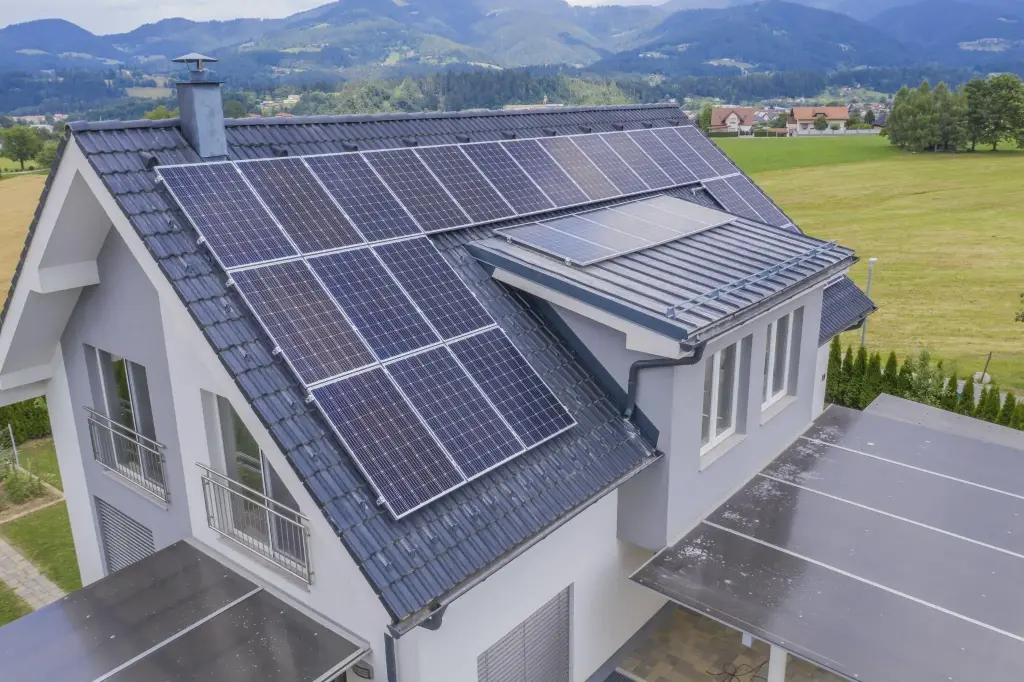
#3: Roof size and availability
When it comes to size, the more roof space you have, the more panels you can install.
For a standard 3.5kW system, you’ll need around 20 square metres of clean roof space.
Here’s a breakdown: An average solar panel will take up 2m² – but you still have to factor in about 40cm on each side of the array, and 3cm between each panel.
Importantly, you’ll also need to account for any chimneys, vents, or skylights, as these can limit the amount of space available for your solar panel installation. An experienced solar panel installer will work around these obstacles.
However, it’s essential to be sure you have enough roof space to produce the energy output you need.
Key takeaway: Make sure you have enough clear space on your roof to accommodate the number of panels needed to meet your energy goals.
#4: How shading affects solar panels
Roof shading happens to be one of the biggest factors as it can reduce the efficiency of your solar panels. This is because nearby trees, buildings, or even chimneys can block the sun’s rays from reaching the solar panels installed, lowering their performance.
So, before you ever install solar panels, it’s important to have a shading analysis done. This can help you understand how shadows will affect your panels at different times of the day and across seasons. If shading is an issue, there are options available! Things like micro-inverters or even trimming nearby trees can help to minimise the impact.
Key takeaway: Analysing and handling shading factors are critical to ensuring that your solar panels work at their top potential.
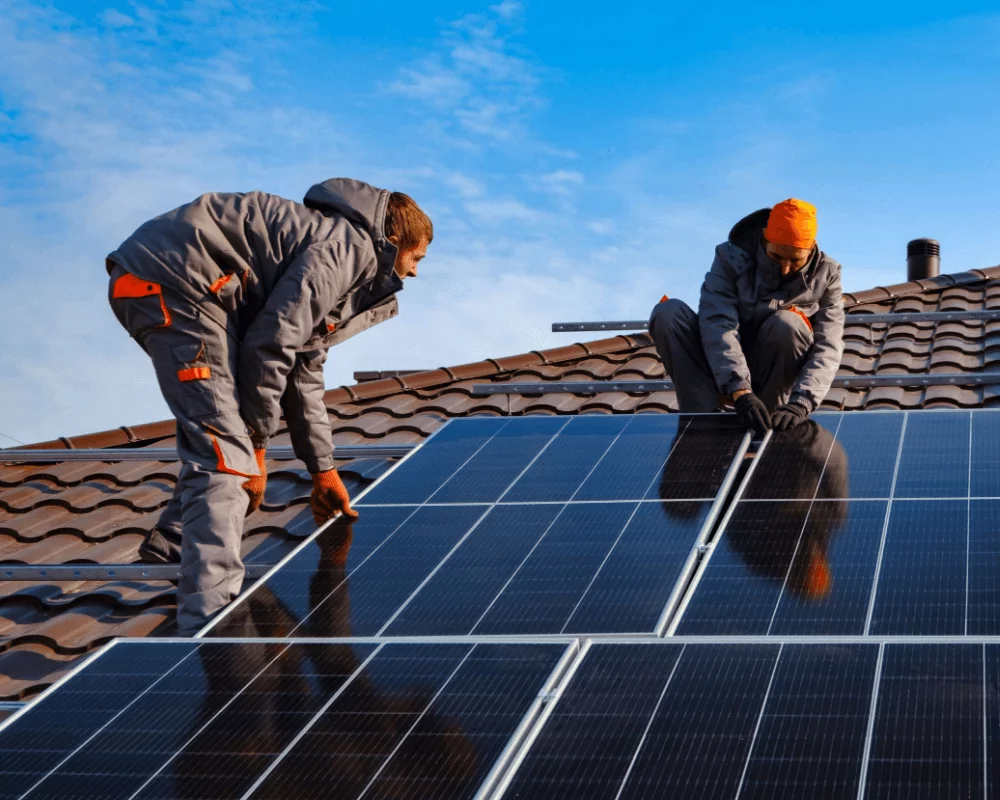
#5: Roof condition: Is your roof strong enough?
Before installing rooftop solar panels, you need to make sure that your roof is in good condition. That means that you need to check for signs of wear and tear.
Is your roof structurally sound?
If your roof has loose tiles, water leaks, or signs of moss growth, these issues need to be handled before installing solar panels.
Solar installers will take a look at the structural integrity of your roof and might recommend a structural report to confirm that it can support the weight of the panels.
When it comes to solar panel installation, when placed on a well-maintained roof, they improve safety and last much longer.
Key takeaway: A structurally sound roof is necessary to safely support a solar panel installation and extend their solar panel lifespan.
#6: Roof materials: Best and worst for solar panels
For your solar PV system installation, roof material matters too.
In fact, it will affect just how easy it is to install the solar array.
- Asphalt shingles and metal roofs are ideal. This is because they are durable and easy to work with.
- If you have tile or slate roofs, a solar panel system installation is still possible. However, it may require more care and could increase the labour costs.
- Some roofing materials, like those for thatch roofs, or glass roofs, are generally unsuitable for solar panels.
- Additionally, asbestos would have to be removed and isn’t a suitable material for solar panel installs. This is due to fire risks, weight limits or difficulty securing mounting systems
Key takeaway: Many common roofing materials are suitable for solar panels (asphalt, metal), but certain types may require additional work or won’t work at all.
#7: Will you need planning permission?
Most of the time in the UK, installing solar panels for your home isn’t going to require planning permission. A solar installation doesn’t generally fall under ‘permitted development’ rules. This means you can install a solar panel with the need for any special approvals.
However, there are a few exceptions.
For instance, if your home is a listed building or in a conservation area, this could mean that some additional permissions may be needed.
If you’re unsure about the matter, it’s always a good idea to check with the National Planning Portal or simply reach out to a solar expert at Soly.
Key takeaway: Most UK homes won’t need planning permission to install solar panels. However, certain areas or building types may require it.
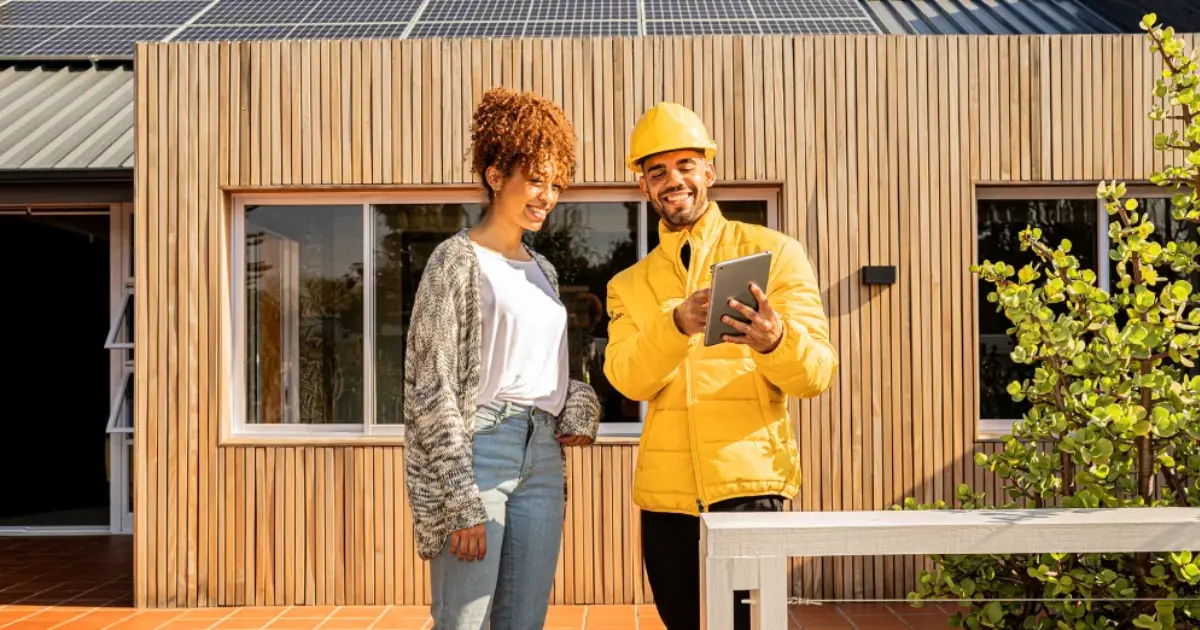
#8: Solar panel installation costs
Solar panel installation cost in the UK is going to depend on several factors.
These include your roof type, the number of panels you need, and any additional equipment, like solar batteries. In general, a typical 3.5kW solar PV system costs homeowners anywhere between £6,000 and £8,000 (excluding battery). You can always use Soly’s online configurator to quickly estimate just how many panels you need and how much energy output you’ll get back. Our online consultants are also capable of assessing roof suitability remotely, thanks to our innovative satellite technology.
While the initial costs may seem a bit steep, the long-term savings through lower energy bills, on top of the current Zero VAT, and the Smart Export Guarantee (SEG) can help you recoup your investment.
Additionally, it’s important to think about any roof maintenance, such as repairs or replacements, beforehand to avoid any additional costs down the road.
Key takeaway: Installation costs vary based on roof type and setup, but long-term savings and financial incentives can make solar panels a smart investment.
#9: How your home location affects solar panel performance
The amount of sunshine your home receives varies depending on your location in the UK.
In fact, homes in southern regions like London, Kent, and Cornwall get more sunlight which makes solar panels more efficient.
In northern areas like Scotland or Northern Ireland, there’s less direct sunshine, but solar panels can still be effective.
This is especially the case with modern solar technology, as it works better in low-light conditions. Additionally, the local weather in your region will play its own role, with frequent rain or overcast days causing a slight reduction in solar panel efficiency.
But don’t let that deter you! These newer solar panel types can still do quite well in conditions such as these.
Key takeaway: Southern UK homes tend to get more sunshine, but even homes in the north can truly benefit from modern solar technology with the right setup.
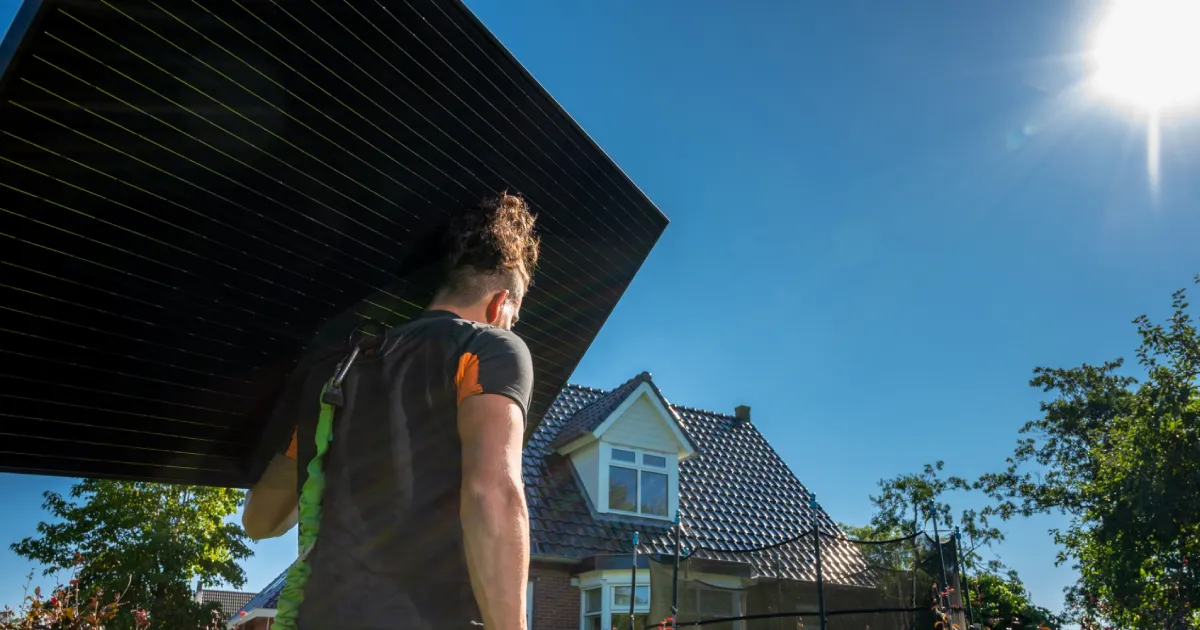
FAQ
How do I know if my roof will support solar panels?
To see if your roof can support solar panels, you typically need to have a professional assess its structural integrity. At Soly, we’re capable of completing this step remotely, saving you time! Otherwise, either a structural engineer or a professional solar installer will be able to evaluate the load-bearing capacity based on the roof’s condition, material, and age. Most roofs can handle the weight of the solar panels. However, if there are any signs that the roof isn’t structurally sound like loose tiles or leaks, they should be addressed first.
What roofs are not suitable for solar panels?
Thatch roofs and glass roofs are typically not suitable for solar panels due to fire safety risks and insufficient strength. Additionally, if asbestos is involved, it will need to be removed. Alternatively roofing materials that are common and suitable for solar include asphalt shingles and metal, among others.
Am I allowed to put solar panels on my roof?
In the UK, most homes can install solar PV without planning permission as it falls under permitted development. But if your home is in a conservation area or is a listed building, you may need special approval before you move forward with your plans for solar.
Will solar panels fit on my roof?
When you want to know how many solar panels you need, that number depends on the size and layout of your roof. A typical 3.5kW solar panel system needs around 20-30 square metres of clean, unobstructed space. Additionally, factors like roof vents and chimneys can play a part in just how many panels can be installed on your roof.
Final thoughts: Is my house suitable for solar panels?
Looking at the big picture here, we can see that determining whether your house is suitable for solar panels involves considering a few key factors. Your roof orientation, pitch, size, and condition of your roof, as well as the amount of sunshine you receive are all going to equally be involved.
Additionally, at Soly, we like to make things easy with our digital tools to help you plan your solar panel installation from the comfort of your own home. So use our Soly online configurator to calculate exactly how many solar panels you need, how much electricity you can generate, and how much you could save.
When we optimise these factors, we can maximise the efficiency of your solar panel system so that you can enjoy significant savings on your energy bills.
Why choose Soly for your solar panel needs?
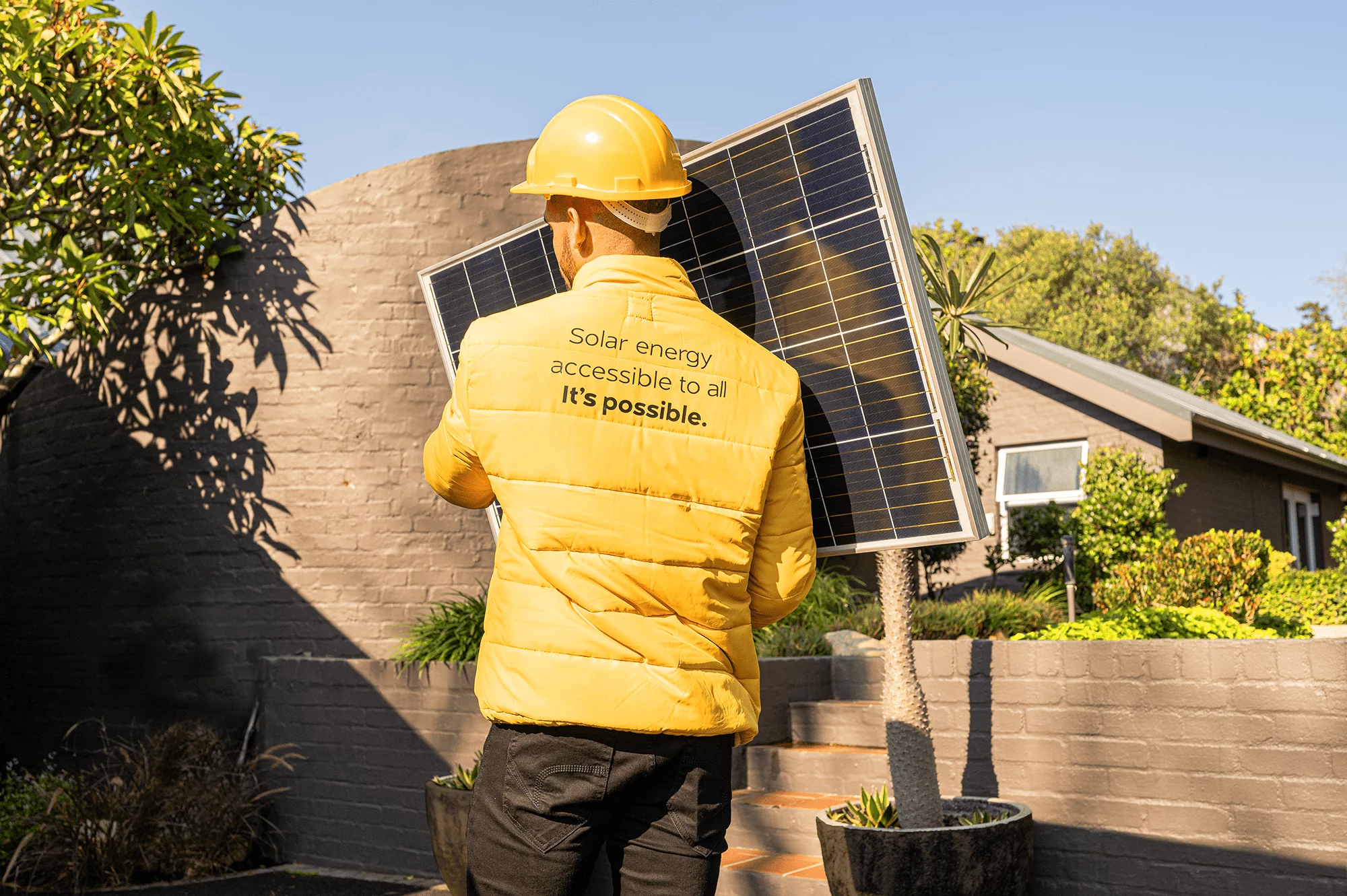
At Soly, we make solar energy accessible and ensure your photovoltaic system lasts as long as possible, performing at its best. Here’s why we’re the ideal choice for your solar energy journey:
- Affordable financing: We understand that upfront costs can be a barrier to going solar. That’s why we’ve partnered with Hometree Finance, providing tailored, competitive financing with instant, personalised offers.
- Referral benefits: Soly offers the best referral scheme in the solar market. As a Soly customer, you can earn £300 for each friend you refer who installs a system with Soly—with no limits! This can significantly help reduce your payback period. For example, one of our customers, Martyn, managed to reduce his payback period by nearly a year by referring just three friends.
- High-quality panels: We use only the best solar panels, offering monocrystalline solar panels from Jinko Solar. Known for their efficiency and durability, these monocrystalline solar panels can last for up to 40 years, ensuring you get the most out of your investment.
- Trusted reputation: Soly is proud to be highly rated on platforms like TrustPilot and Google and recognized as a certified Which? Trusted Trader. We’ve built a reputation for excellence, earning the trust of countless satisfied customers, with our commitment to quality evident in every installation.
- Accredited installers: We work exclusively with local installers nationwide who are accredited by HIES, TrustMark, and MCS, ensuring that your solar system is installed with the highest industry standards in mind. Proper installation plays a huge role in maximising the lifespan of your solar panels.
- Expertise you can trust: With over 10 years of experience in the solar industry, we know how to deliver the best solar solutions tailored to your needs. Our team of experts will ensure your system is designed to last.
- Peace of mind: We provide up to 25-year guarantees for our solar panels and 15-year guarantees for our solar batteries. This means you can have peace of mind knowing your investment is protected for decades to come.
Reach out to our solar experts today to discover how Soly can help you transition to clean, renewable energy with the best products and financing options.